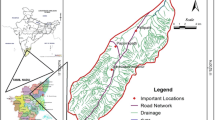Abstract
This study contains Runoff Model which integrates GIS and the hydrological model. HEC-RAS software was used to simulate rainfall volume and create a model result in Kaleshwaram Watershed, Telangana, India. The Watershed delineation has considered Maneru Dam, proposed Tummadihatty Barrage on Pranahita River. The Medigadda Barrage has coordinates 18° 42ʹ 56ʹʹ N 80° 04ʹ 33ʹʹ E have been considered for the estimation of floodwater and runoff volume. The study area has Catchment No. 313, Godavari sub-basin. (Telangana state India). The Digital model results from the simulation were compared with the observed water storage data for the storms that occurred during the monsoon season for the year 2020. The Digital model (DEM) results will benefit the future forecast of flood volume and estimate runoff in Medigadda Barrage. During rainfall and run-off, volume simulation can identify the streamlines according to the topography, flow velocity, depth, and volume of water. Rain data of 141 stations within 22,670 Sq.km have taken to understand rainfall patterns and Rainfall-Runoff simulations. The velocity, depth and volume flow has observed for the given simulation as 5.3 m/s, 20 m and 26000m3 respectively. In this paper, it is limited for the one simulation run for the year 2020 to avoid the more accumulation of data and confusion.













Similar content being viewed by others
Data availability
Data sharing not applicable to this article as no datasets were generated or analysed during the current study.
References
Anderson ML, Chen ZQ, Kavvas ML, Feldman A (2002) Coupling HEC-HMS with atmospheric models for prediction of watershed runoff. J Hydrol Eng 7:312–318
Behbahani SMR, Ghajarnia HR, Bani-Habib ME (2006) The effect of base map scale on the accuracy of floodplain zoning using IS. J Applied Gd Sci 6:20–26
Bhuvan (2010) ISRO Open data Archive, Indian Geo-platform of Indian Space Research organization. Web Information Manager
Binejad HT (2012) Rain fall and run of simulation modelling of Karun River using the HEC-RAS and HEC—HMS models. Size District Iron JAS 12(18):1900–1908
Costabile P, Costanzo C, Ferraro D, Macchione F, Petaccia G (2020) Performances of the new HEC-RAS version 5 for 2-D hydrodynamic-based rainfall-runoff simulations at basin scale: comparison with a state-of-the art model. Water 12(9):2326
CWC (2020) Central Water Commission krishna Godavari basin A.C. Guards. Hyderabad
Dastorani MT, Talebi A et al (2011) Determination of the ability of Hec- HMS model components in rain fall – run off simulation res. J Envtron Sci 5:790–797
Ezz H (2017) Integrating GIS and HEC-RAS to model Assiut plateau runoff. Egypt J Remote Sens Space Sci. https://doi.org/10.1016/j.ejrs.2017.11.002
Gangi F (2020) Applicazione delle Shallow Water Equations per la Simulazione Numerica a Scala di Bacino Degli Eventi Alluvionali. Ph.D. Thesis, Uni Cal, Italy
Haghiabi AH (2012) Evaluation of HEC-RAS Ability in Erosion and Sediment Transport Forecasting. World Appl J Sci 17(11):1490–1497
HEC-RAS river analysis system (2016) User’s manual, US Army Corps of Engineers. Institute for water resources, Hydrologic Engineering centre 609, second street Davis, CA 95616-4687, USA
HEC-RAS river analysis system (2017) User’s manual, US Army Corps of Engineers. Institute for water resources, hydrologic engineering centre
Hudson PF, Colditz RR (2003) Flood delineation in a large and complex alluvial valley, lower Panuco basin. Mexico J Hydro 280:229–245
Husain A (2017) Flood Modelling by using HEC-RAS. Int J Eng Trends Technol (IJETT). https://doi.org/10.14445/22315381/IJETT-V50P201
Irrigation & Cad Department (2019) Eia Report Karimnagar – 505527, Telangana state; India (Environmental Health & Safety Consultants Pvt Ltd) February, 2019 Document No. Ehsc/Icad/Lmd/Sypc/2017-18/Klis
Jayakrishnan R, Srinivasan R, Arnold JG (2004) Comparison of rain gauge and WSR-88D Stage III precipitation data over the Texas-gulf basin. J Hydro 292:135–152
Khadka (2018) American Geophysical Union, Fall Meeting 2018, abstract #HH32F-03, Bibe code 2018AGUFM.H32F..03K
Liu Z, Merwade V, Jafarzadegan K (2019) Investigating the role of model structure and surface roughness in generating flood inundation extents using one- and two-dimensional hydraulic models. J Flood Risk Mngt 12(1):e12347. https://doi.org/10.1111/jfr3.12347
Mahajan R, Campbell E and Bardol M (2017) Eosyntec Consultants, HECRAS 2D: are you ready for the revolution in the world of hydraulic modelling?
Pinos J, Timbe L (2019) Performance assessment of two-dimensional hydraulic models for generation of flood inundation maps in mountain river basins. Water Sci Eng 12:11–18
Rahul (2017) urban flash flood modeling using remotely sensed data and Hec-ras: pune case study. In: Asian conference on remote sensing at New Delhi
Reed SR, Maidment DR (1995) A GIS procedure for merging nexrad precipitation data and digital elevation models to determine rainfall-runoff modelling parameters (CRWR report 95–3). Center for Research in Water Resources, Austin, TX
Salimi S, Ghanbarpour MR, Solaimani K, Ahmadi MZ (2008) Floodplain mapping using hydraulic simulation model in GIS. J Applied Sci 8:660–665
The Kaleshwaram Lift Irrigation Project (2019) (KLIP) is a multi-purpose irrigation project on the Godavari River in Kaleshwaram, Bhupalpally, Telangana, India
Whiteaker TL, Maidment DR (2004) Geographically integrated hydrologic modelling system. Center for Research in Water Resources, Austin, TX, USA
Acknowledgements
It is special thanks to the C.W.C, India, Telangana state Irrigation and cad Department and ISRO, Buvan, etc., organizations from which to obtaining adequate data for the quality research and result.
Funding
No funding is provided for the preparation of manuscript.
Author information
Authors and Affiliations
Contributions
All authors are equal contributions in this work.
Corresponding author
Ethics declarations
Conflict of interest
Authors S. Venkatcharyulu, Dr. G.K. Viswanadh declare that they have no conflict of interest.
Ethical approval
This article does not contain any studies with human participants or animals performed by any of the authors.
Consent to participate
Two authors have equal contributions.
Consent to publish
Reviewer and Editors can publish this work.
Additional information
Publisher's Note
Springer Nature remains neutral with regard to jurisdictional claims in published maps and institutional affiliations.
Rights and permissions
About this article
Cite this article
Venkatcharyulu, S., Viswanadh, G.K. Runoff volume model for Godavari sub-basin using HEC-RAS software. Model. Earth Syst. Environ. 8, 3577–3589 (2022). https://doi.org/10.1007/s40808-021-01311-4
Received:
Accepted:
Published:
Issue Date:
DOI: https://doi.org/10.1007/s40808-021-01311-4




